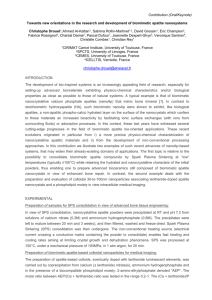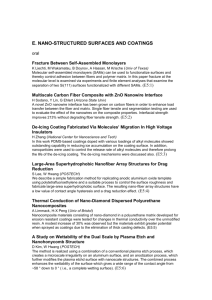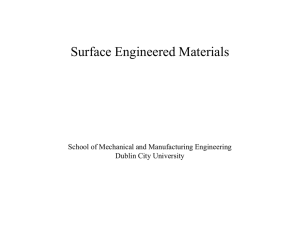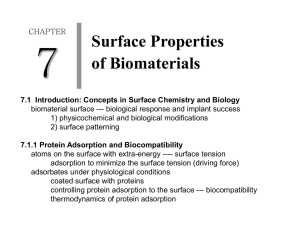Characterization of biomimetic calcium phosphate coatings
advertisement
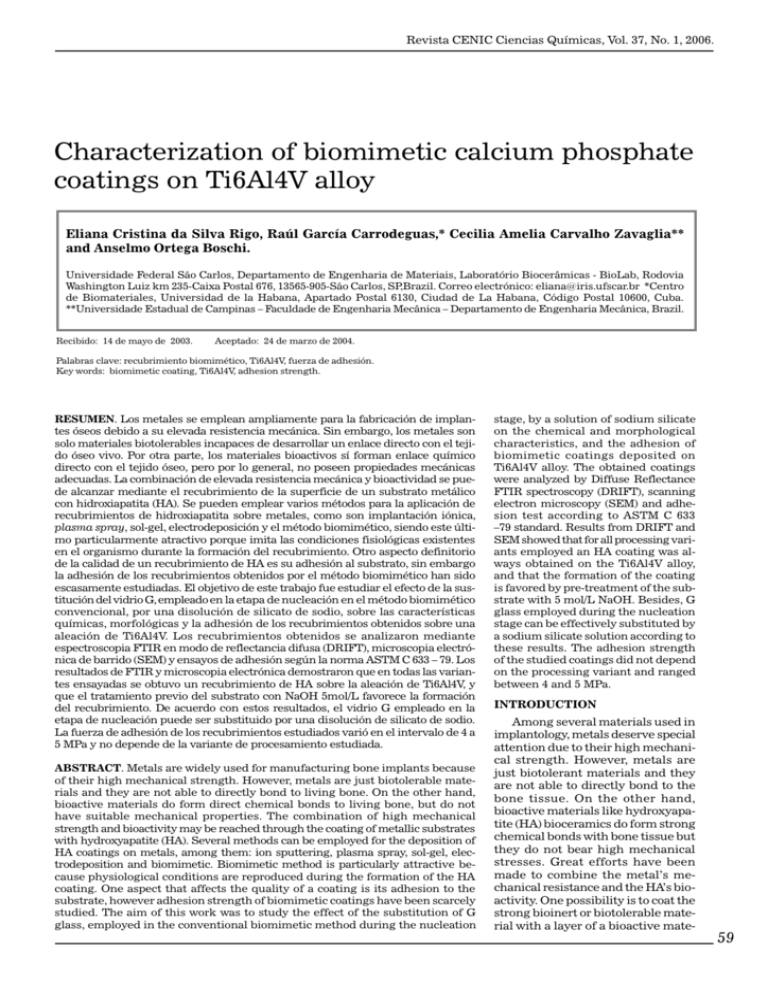
Revista CENIC Ciencias Químicas, Vol. 37, No. 1, 2006. Characterization of biomimetic calcium phosphate coatings on Ti6Al4V alloy Eliana Cristina da Silva Rigo, Raúl García Carrodeguas,* Cecilia Amelia Carvalho Zavaglia** and Anselmo Ortega Boschi. Universidade Federal São Carlos, Departamento de Engenharia de Materiais, Laboratório Biocerâmicas - BioLab, Rodovia Washington Luiz km 235-Caixa Postal 676, 13565-905-São Carlos, SP,Brazil. Correo electrónico: eliana@iris.ufscar.br *Centro de Biomateriales, Universidad de la Habana, Apartado Postal 6130, Ciudad de La Habana, Código Postal 10600, Cuba. **Universidade Estadual de Campinas Faculdade de Engenharia Mecânica Departamento de Engenharia Mecânica, Brazil. Recibido: 14 de mayo de 2003. Aceptado: 24 de marzo de 2004. Palabras clave: recubrimiento biomimético, Ti6Al4V, fuerza de adhesión. Key words: biomimetic coating, Ti6Al4V, adhesion strength. RESUMEN. Los metales se emplean ampliamente para la fabricación de implantes óseos debido a su elevada resistencia mecánica. Sin embargo, los metales son solo materiales biotolerables incapaces de desarrollar un enlace directo con el tejido óseo vivo. Por otra parte, los materiales bioactivos sí forman enlace químico directo con el tejido óseo, pero por lo general, no poseen propiedades mecánicas adecuadas. La combinación de elevada resistencia mecánica y bioactividad se puede alcanzar mediante el recubrimiento de la superficie de un substrato metálico con hidroxiapatita (HA). Se pueden emplear varios métodos para la aplicación de recubrimientos de hidroxiapatita sobre metales, como son implantación iónica, plasma spray, sol-gel, electrodeposición y el método biomimético, siendo este último particularmente atractivo porque imita las condiciones fisiológicas existentes en el organismo durante la formación del recubrimiento. Otro aspecto definitorio de la calidad de un recubrimiento de HA es su adhesión al substrato, sin embargo la adhesión de los recubrimientos obtenidos por el método biomimético han sido escasamente estudiadas. El objetivo de este trabajo fue estudiar el efecto de la sustitución del vidrio G, empleado en la etapa de nucleación en el método biomimético convencional, por una disolución de silicato de sodio, sobre las características químicas, morfológicas y la adhesión de los recubrimientos obtenidos sobre una aleación de Ti6Al4V. Los recubrimientos obtenidos se analizaron mediante espectroscopia FTIR en modo de reflectancia difusa (DRIFT), microscopia electrónica de barrido (SEM) y ensayos de adhesión según la norma ASTM C 633 79. Los resultados de FTIR y microscopia electrónica demostraron que en todas las variantes ensayadas se obtuvo un recubrimiento de HA sobre la aleación de Ti6Al4V, y que el tratamiento previo del substrato con NaOH 5mol/L favorece la formación del recubrimiento. De acuerdo con estos resultados, el vidrio G empleado en la etapa de nucleación puede ser substituido por una disolución de silicato de sodio. La fuerza de adhesión de los recubrimientos estudiados varió en el intervalo de 4 a 5 MPa y no depende de la variante de procesamiento estudiada. ABSTRACT. Metals are widely used for manufacturing bone implants because of their high mechanical strength. However, metals are just biotolerable materials and they are not able to directly bond to living bone. On the other hand, bioactive materials do form direct chemical bonds to living bone, but do not have suitable mechanical properties. The combination of high mechanical strength and bioactivity may be reached through the coating of metallic substrates with hydroxyapatite (HA). Several methods can be employed for the deposition of HA coatings on metals, among them: ion sputtering, plasma spray, sol-gel, electrodeposition and biomimetic. Biomimetic method is particularly attractive because physiological conditions are reproduced during the formation of the HA coating. One aspect that affects the quality of a coating is its adhesion to the substrate, however adhesion strength of biomimetic coatings have been scarcely studied. The aim of this work was to study the effect of the substitution of G glass, employed in the conventional biomimetic method during the nucleation stage, by a solution of sodium silicate on the chemical and morphological characteristics, and the adhesion of biomimetic coatings deposited on Ti6Al4V alloy. The obtained coatings were analyzed by Diffuse Reflectance FTIR spectroscopy (DRIFT), scanning electron microscopy (SEM) and adhesion test according to ASTM C 633 79 standard. Results from DRIFT and SEM showed that for all processing variants employed an HA coating was always obtained on the Ti6Al4V alloy, and that the formation of the coating is favored by pre-treatment of the substrate with 5 mol/L NaOH. Besides, G glass employed during the nucleation stage can be effectively substituted by a sodium silicate solution according to these results. The adhesion strength of the studied coatings did not depend on the processing variant and ranged between 4 and 5 MPa. INTRODUCTION Among several materials used in implantology, metals deserve special attention due to their high mechanical strength. However, metals are just biotolerant materials and they are not able to directly bond to the bone tissue. On the other hand, bioactive materials like hydroxyapatite (HA) bioceramics do form strong chemical bonds with bone tissue but they do not bear high mechanical stresses. Great efforts have been made to combine the metals mechanical resistance and the HAs bioactivity. One possibility is to coat the strong bioinert or biotolerable material with a layer of a bioactive mate- 59 Revista CENIC Ciencias Químicas, Vol. 37, No. 1, 2006. rial.1 In this case, the most challenging difficulty is to obtain a successful union between the bioactive layer and the substrate. Several methods can be employed for the deposition of a bioactive HA coating on metals, among them: ion sputtering, plasma spray, sol-gel, electrodeposition and biomimetic.1 Biomimetic method is particularly attractive because physiological conditions are reproduced during the formation of the HA coating. As described by the first time by Abe et al., biomimetic method consists in to face the substrate to be coated to a plate of G glass and to immerse the set in simulated body fluid for 7 d at 37 °C .2 During this stage the glass surface and the solution exchange ions which induce favorable conditions for apatite nucleation on the substrate. By immersing the substrate in 1.5 SBF at 37 °C for an additional period of 7 d the apatite nuclei grow and coalesce into a layer of up to 1 µm of thickness . A large variety of substrates, including glasses, sintered ceramics, metals and organic polymers have been apatite-coated by the biomimetic method.2,3 The creators of the biomimetic method assigned an important role to the silicate ions dissolved from the G glass in the formation of apatite nuclei on the surface of the substrate to coat, and they found a maximum Si concentration of ≈ 100 ppm in SBF after equilibrating 6 d on G Glass.4, 5 One aspect that affects the quality of a coating is its adhesion to the substrate, however adhesion strength of biomimetic coatings have been scarcely studied. Values of adhesion strength of 0 to 4 MPa have been reported for coatings on several organic polymers than can be increased up to 10 MPa by pretreatment of the substrate with NaOH or HCl solutions, or plasma in oxidizing atmosphere.4 However, the authors have not found reports on the adhesion strength of biomimetic coatings on Ti6Al4V alloy. This work was aimed to study the effect of the substitution of G glass, employed in the conventional biomimetic method during the nucleation stage, by a solution of sodium silicate, on the chemical and morphological characteristics, and the adhesion of biomimetic coatings deposited on Ti6Al4V alloy. EXPERIMENTAL PROCEDURE Coating method 60 Ti6Al4V disks with 3 cm of diameter and 0.5 cm of thickness were utilized. Some of them were submit- ted to a previous surface treatment with a NaOH 5 mol/L solution at 60 ºC for 24 h followed by heating at 600 ºC for 1 h .4 The G glass was prepared from a mixture of CaF 2 , CaCO 3 , SiO 2 , (NH4)2HPO4 and (MgCO3)4 · Mg(OH)2 · 5H2O, all of analytical purity, processed as reported.3 The solutions utilized were SBF, 1.5 SBF2, 3 and sodium silicate solution (SS) containing 100 ppm of Si as another nucleating agent. They were prepared from NaCl, KCl, K2HPO4, CaCl2 · 2H2O, MgCl2 · 6H2O, NaHCO 3 , Na 2 SO 4 and (Na 2 O) 0,28 · SiO2, all of analytical purity. The pH of all solutions was adjusted to 7.25 at 37 °C with HCl 1 mol/L and tris(hidroxymetil)aminomethane and kept in closed polyetylene flasks. Two distinct coating conditions were adopted: Treatment T1. Ti6Al4V disks with and without NaOH 5 mol/L pretreatment were placed over 2g of G glass particles, enclosed in a polyetylene flask and filled with 25 cm3 of SBF. The flasks with the samples were incubated at (37 ± 1) °C for 7 d . The samples were removed, washed by immersion in distilled and deionized water and reimmersed in 1.5 SBF and incubated for an additional period of 6 days at (37 ± 1) °C . Finally, the samples were removed, washed in water and dried at room temperature. Treatment T2. Ti6Al4V disks with and without NaOH 5 mol/L pretreatment were placed in a polyetylene flask and filled with 25 cm3 of SS. The flasks with the samples were incubated at (37 ± 1) °C for 7 d . The samples were removed, washed by immersion in distilled and deionized water and reimmersed in 1.5 SBF and incubated for an additional period of 6 d at (37 ± 1) °C . Finally, the samples were removed, washed in water and dried at room temperature. IR Spectroscopy The coated specimens were analyzed in a diffuse reflectance device (Drift CollectorTM) coupled to a Fourier Transform Infrared spectrometer (FTIR Nicolet Magna 550). Scanning Electron Microcopy The coated surfaces were examined in a scanning electron microscope (Leica/Cambridge, model Stereoscan 440). Adhesion strength test The adhesion strength of the coatings was measured according to the ASTM C633-79 Standard, in an universal testing machine Instron 5500 R at a head speed of 1 mm/s . The coated substrates were glued to the test heads of the machine with DP 460 (3M) epoxy adhesive plaster. RESULTS AND DISCUSSIONS For the substrates submitted to T1 (Fig. 1a) were observed IR absorption bands at 600 and 1 040 cm−1 of the PO43− ion; at 870, 1 410 and 1 490 cm−1 of the CO 32− ion; at 3 000-3 600 and 1 650 cm−1 of H2O, characteristic of type B carbonate-apatite.6-9 Similar IR spectra were found for samples treated according to T2 (Fig. 1b). These results showed that the sodium silicate solution (SS) can be used to effectively replace the G glass as source of silicate ions. The mechanism of the apatite layer formation by the biomimetic method is the following: (1) silicate ions dissolved from the G glass are adsorbed on the substrate, (2) apatite nucleation occurs on the adsorbed silicate ions from the Ca2+ and PO43− ions present in the SBF, (3) apatite nuclei grow directly on the substrate by a reaction with the solution which is supersaturated to apatite.2 The silicate ions adsorbed on the surface of the substrate produce silanol groups (Si-OH) which are accepted to be the responsible for the apatite nucleation action.4 The substrate pretreated with 5 mol/L NaOH and submitted to T1 (Fig. 2a) showed the IR bands described above characteristic of the PO43−, CO32− and H2O groups.3-6 When the substrate pretreated with NaOH was submitted to treatment T2 (Fig. 2b), the IR spectrum was very similar. The samples under study were analyzed by SEM and the resulting images are shown in Figures 3 and 4. For substrates treated by T1 (Fig. 3a), the formation of a compact dense layer can be observed, and the formation of scarce globules on this layer, composed of primary agglomerated particles. This morphology was also found for the coating obtained by T2 (Fig. 3b). The substrate pretreated with 5 mol/L NaOH and treated by T1, showed a denser inferior layer and abundant rounded agglomerates on it (Figure 4a) and the same morphology was observed for samples pretreated in 5 mol/L NaOH and submitted to T2 (Fig. 4b). According to these results was concluded that the pretreatment Reflectance (%) Revista CENIC Ciencias Químicas, Vol. 37, No. 1, 2006. H2 O a) T1 CO32− CO32− PO43− PO43− H2 O b) T2 H2 O CO32− PO43− PO43− H2 O 4 000 3 500 CO32− 3 000 2 500 2 000 1 500 1 000 500 Wave number (cm ) −1 Reflectance (%) Fig. 1. Diffuse reflectance FTIR spectra of the apatite coatings obtained onto Ti6Al4V alloy by treatments T1 (a) and T2 (b). PO43− CO32− a) NaOH - T1 H2O CO32− PO43− H 2O b) NaOH - T2 H2 O CO3 H 2O 4 000 3 500 2− PO43− CO32− PO43− with 5 mol/L NaOH enhanced the nucleation and posterior growth of the apatite layer over the Ti6Al4V surface. This agree with previous reports where was observed that the pretreatment with 5 mol/L NaOH develops surface Ti-OH groups analogous to silanols that may also act as nucleation sites for apatite.4 Therefore, the apatite nucleation occurs on Ti-OH groups as effectively as on silanols when the treated surface is immersed in SBF or 1.5 SBF. The specimens, coated according to the above described methods, were glued to inox supports with epoxy DP 460 (3M) adhesive whose traction strength reaches 25 MPa . The adhesive was let cure during 48 h at room temperature. The values of adhesion strength were obtained for all coating procedures (Table 1). No significant differences (p = 0.01) were found among them. The failure not always occurred at the coating-substrate interface, but at the adhesivesupport interface. In such cases, the obtained value was neglected and a new sample was tested. For each kind of coating at least five samples showing failure at the interface coatingsubstrate were examined. It was noticed that factors like homogeneity and amount of adhesive, pressing and curing times, and the testing device alignment strongly affect the results of the test. The adhesion strength values obtained for all coatings were similar to that reported for a conventional biomimetic apatite coating on poly(ether sulfone) [4.4 (0.3) MPa]. CONCLUSIONS 3 000 2 500 2 000 1 500 1 000 500 Wave number (cm ) −1 Fig. 2. Diffuse reflectance FTIR spectra of the apatite coatings obtained onto Ti6Al4V alloy by combining 5 mol/L NaOH pre-treatment and treatments T1 (a) and T2 (b). The formation of an apatitic coating on the Ti6Al4V alloy was always observed, independently of the method employed, which indicates that G glass can be effectively substituted by a solution of sodium silicate buffered to pH 7.25 and containing 100 ppm Si. Pretreating of the alloy surface with 5 mol/L NaOH improved the quality of the apatite coating. The adhesion strength of the coating to the substrate did not depend on the method employed and was similar to the value reported for an apatitic biomimetic coating on poly(ether sulfone) obtained in the presence of G glass. ACKNOWLEDGEMENTS a b Fig. 3. SEM micrographs of the apatite coatings obtained onto Ti6Al4V alloy by treatments T1 (a) and T2 (b). The authors are grateful to FAPESP (Sao Paulo, Brazil) for the support of this research under process No. 00/12556-3. 61 Revista CENIC Ciencias Químicas, Vol. 37, No. 1, 2006. BIBLIOGRAPHY a b Fig. 4. SEM micrographs of the apatite coatings obtained onto Ti6Al4V alloy by combining 5 mol/L NaOH pre-treatment and treatments T1 (a) and T2 (b). Table 1. Adhesion strength of the apatite coatings obtained onto Ti6Al4V alloy. Coating a 62 Average adhesion strength (MPa)a T1 4,5 (1,8) T2 5,0 (1,7) NaOH - T1 4,1 (1,1) NaOH - T2 4,0 (1,6) NaOH - T2 4,0 (1,6) Standard deviation in brackets. 1. Rigo E.C.S., Oliveira L.C., Santos L.A., Carrodeguas RG. and Boschi A.O. Revista Brasileira de Engenharia Biomédica, 15, 21-29, 1999. 2. Abe Y., Kokubo T. and Yamamuro T. J. Mater. Sci.: Mater. Med., 1, 233-38, 1990. 3. Hata K., Kokubo T., Nakamura T. and Yamamuro T. J. Am. Ceram. Soc., 78, 1049-53, 1995. 4. Kokubo T. Anales de Química Int. Ed., 93, S49-S55, 1997. 5. Kokubo t., Kushitani H., Ohtsuki C., Sakka S., Yamamuro T. J. Mater. Sci.: Mater. Med., 3, 79-83, 1992. 6. Barrère F., Layrolle P., Van Blitterswijk C.A. and De Groot K. Bone, 25, 107S111S, 1999. 7. Stoch A., Jastrzebski W., Brozek A., Trybalska B., Cichocinska M. and Szarawara E. J. Molecular Structure 511-512, 287-294, 1999. 8. Slósarczyk A., Paluszkiewicz C., Gawlicki M. and Paszkiewicz Z. Ceramics International, 23, 297-304, 1997. 9. Stoch A., JastrzebskI W., Brozek A., Stoch J., Szaranice J., Trybalska B. and Kmita G. J. Molecular Structure, 555, 375-382, 2000.

